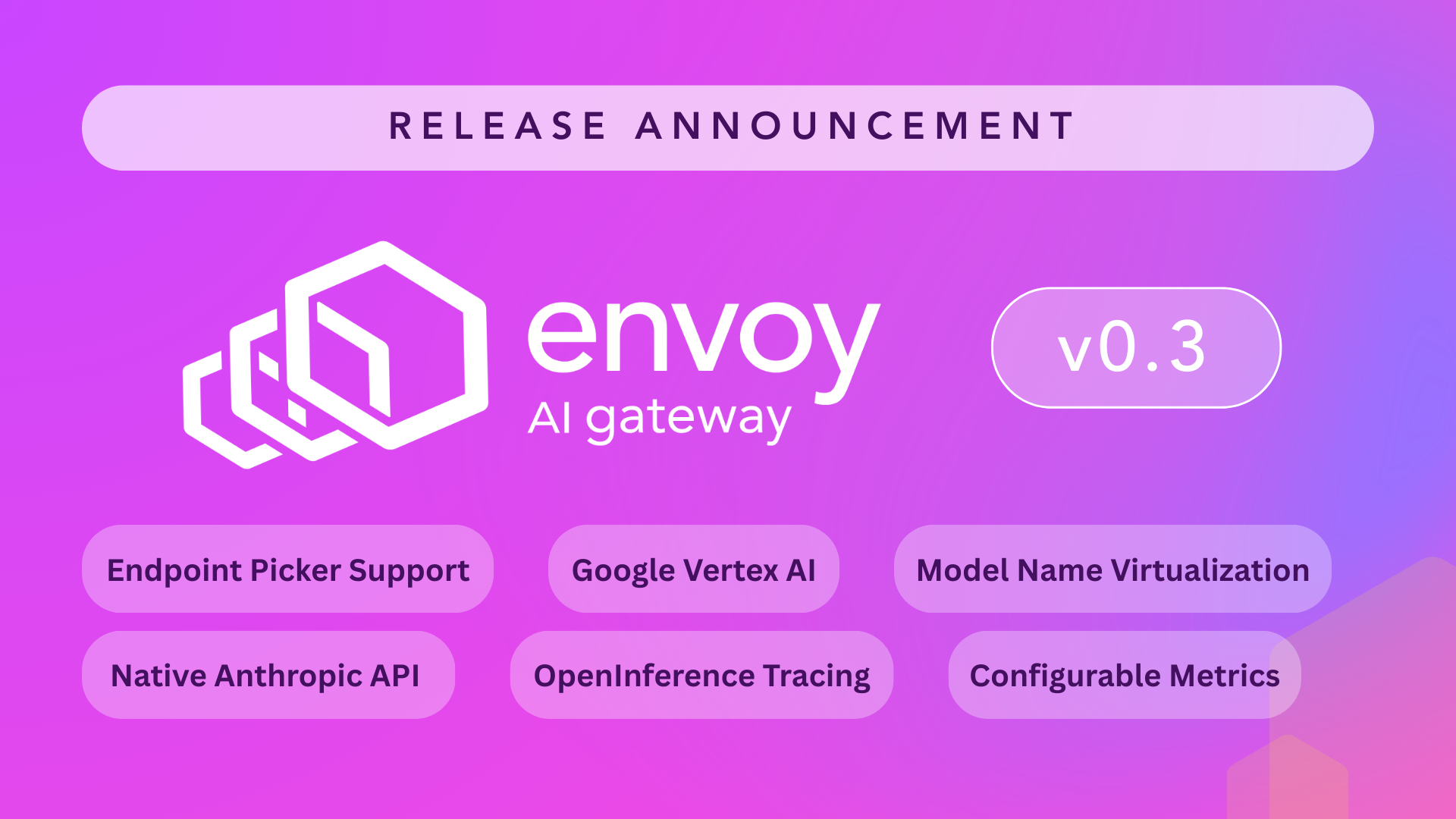Announcing the Envoy AI Gateway v0.3 Release

The Envoy AI Gateway v0.3 release introduces intelligent inference routing through Endpoint Picker (EPP) integration, expands our provider ecosystem with Google Vertex AI Production Support as well as Native Anthropic API, and delivers Enterprise-Grade Observability with OpenInference tracing.
The Big Shifts in v0.3
Envoy AI Gateway v0.3 isn't just another feature release; it's a fundamental shift toward intelligent, production-ready AI infrastructure. This release addresses three critical challenges that have been holding back AI adoption in enterprise environments:
1. From Static to Intelligent Routing
Traditional load balancers treat AI inference endpoints like web servers, but AI workloads are fundamentally different. With Endpoint Picker integration, Envoy AI Gateway now makes intelligent routing decisions based on real-time AI-specific metrics like KV-cache usage, queue depth, and LoRA adapter information.
What this means for you:
| Benefit | Description |
|---|---|
| Latency reduction | Optimal endpoint selection based on real-time AI metrics |
| Automatic resource optimization | Intelligent resource allocation across your inference infrastructure |
| Zero manual intervention | Automated endpoint management without operational overhead |
2. Expanded Provider Ecosystem
We've moved beyond experimental integrations to deliver production-grade support for the AI providers that matter most to enterprises.
Google Vertex AI is now supported with complete streaming capabilities for Gemini models. Anthropic on Vertex AI moves from experimental to production-ready with multi-tool support and configurable API versions.
What this means for you:
| Benefit | Description |
|---|---|
| Unified OpenAI-compatible API | Single interface across Google, Anthropic, AWS, and more providers |
| Enterprise-grade reliability | Production-ready stability for mission-critical AI workloads |
| Provider flexibility | Switch between providers without architectural changes or vendor lock-in |
3. Enterprise Observability for AI
AI workloads require specialized observability that traditional monitoring tools can't provide. v0.3 delivers comprehensive AI-specific monitoring across four key areas.
What this means for you:
| Observability Feature | Description |
|---|---|
| OpenInference tracing | Complete request lifecycle visibility and evaluation system compatibility |
| Configurable metrics labels | Granular monitoring based on request headers for custom filtering |
| Embeddings metrics support | Comprehensive token usage tracking for accurate cost attribution |
| Enhanced GenAI metrics | Improved accuracy with OpenTelemetry semantic conventions |
Notable New Features in v0.3
Endpoint Picker Provider: The Future of AI Load Balancing
A highlight of v0.3 is our integration with the Gateway API Inference Extension, which allows intelligent endpoint selection that understands AI workloads.
# AIGatewayRoute with InferencePool
apiVersion: aigateway.envoyproxy.io/v1alpha1
kind: AIGatewayRoute
metadata:
name: intelligent-routing
spec:
rules:
- matches:
- headers:
- name: x-ai-eg-model
value: meta-llama/Llama-3.1-8B-Instruct
backendRefs:
- group: inference.networking.x-k8s.io
kind: InferencePool
name: vllm-llama3-pool
This isn't just about load balancing; it's about intelligent infrastructure that adapts to your AI workloads in real-time.
Google Vertex AI: Enterprise AI at Scale
Google Vertex AI support moves to production-ready status with:
- GCP Vertex AI Authentication with Service Account Key or Workload Identity Federation.
- Complete Gemini Support with OpenAI API compatibility for function calls, multimodal, reasoning and streaming.
- Complete Anthropic on Vertex AI Support with OpenAI API compatibility for function calls, multimodal, extended thinking and streaming.
- Native Anthropic API via GCP Vertex AI to unlock use case like ClaudeCode.
- Enterprise-grade reliability for mission-critical deployments.
This brings the power of Google's AI platform into your unified AI infrastructure, managed through a single, consistent API.
Comprehensive AI Observability
Traditional observability tools fall short when monitoring AI workloads. v0.3 delivers four significant observability enhancements:
| Enhancement | Feature | Benefit |
|---|---|---|
| OpenInference Tracing Integration | Complete LLM request tracing with timing and token information | Deep visibility into AI request lifecycle |
| OpenInference Tracing Integration | Evaluation system compatibility with tools like Arize Phoenix | Seamless integration with AI evaluation workflows |
| OpenInference Tracing Integration | Full chat completion request/response data capture | Complete audit trail for debugging and analysis |
| Configurable Metrics Labels | Custom labeling based on HTTP request headers | Flexible monitoring and alerting setup |
| Configurable Metrics Labels | Granular monitoring by user ID, API version, or application context | Enhanced filtering and segmentation |
| Configurable Metrics Labels | Enhanced filtering and alerting capabilities | More targeted monitoring and alerts |
| Embeddings Metrics Support | Comprehensive token usage tracking for both chat and embeddings APIs | Better cost control and usage insights |
| Embeddings Metrics Support | Accurate cost attribution across different operation types | Precise cost allocation and budgeting |
| Embeddings Metrics Support | OpenTelemetry semantic conventions compliance | Standardized observability integration |
| Enhanced GenAI Metrics | Improved error handling and attribute mapping | More reliable performance monitoring |
| Enhanced GenAI Metrics | More accurate token latency measurements | Better performance analysis data |
| Enhanced GenAI Metrics | Better performance analysis data | Improved optimization insights |
Model Name Virtualization: Abstraction for Flexibility
The new modelNameOverride field enables powerful model abstraction:
backendRefs:
- name: openai-backend
modelNameOverride: "gpt-4"
- name: anthropic-backend
modelNameOverride: "claude-3"
By abstracting away the model name, application developers can use standardized model names, while the gateway handles provider-specific routing. This is, for example, useful when doing A/B testing, gradual migrations, safeguarding against provider lock-in, and multi-provider strategies.
Unified LLM and non-LLM APIs
Enhanced Gateway resource management by allowing both standard HTTPRoute and AIGatewayRoute to be attached to the same Gateway object.
This provides a unified routing configuration that supports both AI and non-AI traffic within a single gateway infrastructure, simplifying deployment and management.
Community Impact and Momentum
Growing Community
The v0.3 release represents the collaborative effort of our rapidly expanding community:
- Contributors from Tetrate, Bloomberg, Tencent, Google, and Nutanix
- Independent developers driving innovation
- Enterprise adopters providing real-world feedback
This diversity of perspectives has shaped v0.3 into a release that serves both bleeding-edge innovators and enterprise production needs.
Visit on GitHub and Star the Repo to show your support.
Standards Leadership
Our integration with the Gateway API Inference Extension demonstrates our commitment to open standards and vendor-neutral solutions. By building on proven Gateway API patterns, we're ensuring that Envoy AI Gateway remains interoperable and future-proof.
Enabling tracing through OpenInference Tracing Integration further cements and showcases our community's commitment to industry standards, collaboration, and ecosystem integration.
What This Release Enables
| Benefit | Impact |
|---|---|
| Simplified model deployment with intelligent routing | Faster development cycles |
| Performance optimization through real-time metrics | Better model performance |
| Cost control with token-based rate limiting | More predictable operating costs |
| Multi-model support in a single infrastructure | Reduced complexity and maintenance |
| Unified AI infrastructure supporting diverse workloads | Scalable, future-proof architecture |
| Standards-based architecture for long-term sustainability | Vendor-neutral, interoperable solutions |
| Vendor flexibility without architectural changes | Reduced lock-in risk |
| Enterprise observability for production confidence | Production-ready monitoring |
| Reduced operational complexity through automation | Lower operational overhead |
| Improved reliability with intelligent failover | Higher system reliability |
| Better resource utilization across infrastructure | Optimized infrastructure costs |
| Streamlined monitoring with AI-specific telemetry | Simplified troubleshooting |
Get Involved: Join the AI Infrastructure Revolution
The future of AI infrastructure is open, collaborative, and community-driven. Here's how you can be part of it:
| Action | Resource | Description |
|---|---|---|
| 🚀 Try v0.3 Today | Download the release | Get the latest release and start exploring |
| Follow our getting started guide | Step-by-step setup instructions | |
| Explore the examples | Real-world configuration examples | |
| 💬 Join the Community | Weekly Community Meetings | Add to your calendar |
| Slack Channel #envoy-ai-gateway | Join the conversation on Envoy Slack | |
| GitHub Discussions | Share experiences and ask questions | |
| 🛠️ Contribute to the Future | Report Issues | Help us improve by reporting bugs |
| Request Features | Tell us what you need for future releases | |
| Submit Code | Contribute to the next release |
Acknowledgments: The Power of Open Source
v0.3 wouldn't exist without our incredible community. Special recognition goes to:
- Enterprise contributors who provided production feedback and requirements
- Open source maintainers from the Gateway API and CNCF communities
- Individual developers who contributed code, documentation, and ideas
- Early adopters who tested pre-releases and reported issues
Get Started Today
Ready to experience the future of AI infrastructure?
Get started with Envoy AI Gateway v0.3 and see how intelligent inference routing, expanded provider support, and enterprise observability can transform your AI deployments.
The future of AI infrastructure is open, intelligent, and community-driven. Join us in building it.
Envoy AI Gateway v0.3 is available now. For detailed release notes, API changes, and upgrade guidance, visit our release notes page.

